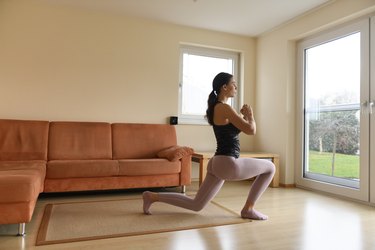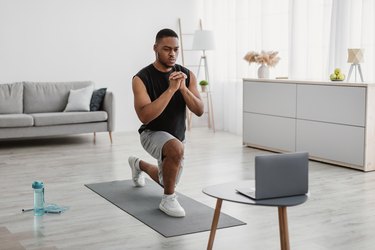

Getting older means strength training becomes even more important. But when the average strength session is up to an hour long, it can be hard to fit it in. Doing compound movements that target your upper and lower body, like the walking lunge with band pull-apart, can help you save time.
Compound movements mean more bang for your buck because you're targeting multiple muscle groups at once, says Denise Harris, CPT, a New York City–based personal trainer and instructor at The Fit In.
Video of the Day
"The walking lunge with band pull-apart is great for older adults because as we begin to age, one's posture might be affected," she tells LIVESTRONG.com. "The tendency is to have a forward rounding of the upper back (kyphosis), so band pull-aparts are an excellent exercise to take the scapula (shoulder blade) out of that protracted state (rounded shoulders) into a retracted state (pulling shoulder blades down and toward your spine) so that your spine is in a more neutral position."
Meanwhile, walking lunges are highly functional because they mimic movements we do on a daily basis, like walking and stepping forward to pick something up from the floor, Harris says. And if you don't have access to much fitness equipment, the walking lunge with band pull-apart requires only one resistance band.
Ahead, Harris breaks down how to do this compound move and shares the perks of doing it regularly. For the best results, Harris recommends doing 10 to 12 reps two to three times a week.
How to Do the Walking Lunge With Band Pull-Apart
- Stand with your feet hip-width apart and hold a long-looped resistance band with one hand near each end, shoulder-width apart. Reach your arms straight in front of your chest with your knuckles facing forward and draw your shoulders back and down.
- Take a step forward with your right foot and lower both legs until your back knee is hovering an inch or two above the ground (or as close as possible). Both legs should form 90-degree angles.
- At the same time, pull both ends of the band wide across your chest while keeping your arms and wrists straight.
- Press your front foot into the ground to stand back up and slowly release the band to return to the starting position. This is 1 rep.
- Repeat, taking a step forward with your left leg.
- Do 10 to 12 reps, alternating legs.
Tip
Modification: If you have knee pain with forward lunges, you can do a reverse lunge instead by stepping your foot back, or you can skip the "walk" and lunge in place, Harris says.
Form Tips:
- Move slowly and with control so you're working your muscles the entire time. "Take your time. Quality over quantity wins every time," Harris says.
- Create a solid base of support by beginning each lunge with your feet hip-width apart. If your stance is too narrow, it can throw off your balance, which is already an issue for many older adults, Harris says.
- Keep your head neutral and aligned with the rest of your spine throughout the exercise. Avoid jutting your head forward and relax your neck and shoulders as you pull the band apart.
Why the Walking Lunge With Band Pull-Apart Is Beneficial for Healthy Aging
1. It Strengthens Your Lower- and Upper-Body Muscles
The band pull-apart primarily targets the muscles in your upper body, including your rhomboids (upper back muscles on each side of your shoulder blades), traps (triangle-shaped back muscles that run from your neck to your mid back and across your shoulder blades), rear deltoids (back shoulder muscles), as well as your rotator cuff muscles (infraspinatus and teres minor), Harris says.
Fortifying these muscles is important with age because they're responsible for maintaining shoulder stability. They allow you to do daily overhead pressing and pulling movements, like placing something on the top shelf and pulling doors open.
At the same time, the walking lunge builds unilateral strength in your lower body, allowing you to focus on your quads, glutes, hips, hamstrings and calves on each leg.
2. It Helps Improve Your Posture
Pulling exercises, like the band pull-apart, help correct poor posture by strengthening your back muscles and opening up your chest muscles, which are often tight from hunching.
As you pull the band apart, it moves your upper back and shoulders from a rounded, slouched position to a more upright and proud posture, where your shoulders are drawn back and down, Harris says.
When you lunge forward, you're also activating your core to keep your upper body stable.
3. It Enhances Your Balance and Coordination
As a unilateral lower-body move, walking lunges build up the muscles in your lower body, including your quads and glutes, which contribute to better balance. Walking lunges and band pull-aparts also both engage your core to help stabilize your body so you can focus on working the intended muscles.
By combining both exercises into one, you're also challenging your muscle coordination. This helps you improve spatial awareness (being aware of your body and its surroundings), which reinforces better balance.
4. It Saves Time at the Gym
By working multiple muscle groups at the same time, walking lunges with band pull-aparts can help you make the most out of your workouts, Harris says. You can also easily store resistance bands and travel with them, so you can do this exercise anywhere.
"With age, loss of muscle mass can occur, and incorporating resistance bands can provide the right amount of resistance for you to help maintain and grow muscle mass," she says. You also have a lower risk of injury with resistance bands than with weights because you don't have to worry about dropping them and hurting yourself.


